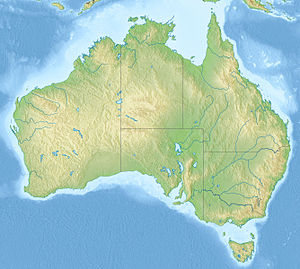Hinchinbrook Island
| Hinchinbrook Island | ||
|---|---|---|
| Hinchinbrook Island (i-cubed Landsat 7 ) | ||
| Waters | Coral sea | |
| Geographical location | 18 ° 14 ′ S , 146 ° 14 ′ E | |
|
|
||
| length | 52 km | |
| width | 10 km | |
| surface | 395 km² | |
| Highest elevation | Mount Bowen 1121 m |
|
| Zoe Falls | ||
The Hinchinbrook Island (English Hinchinbrook Island ) is an island located on the northeast coast of Australia and belongs to the state of Queensland . The island is largely under nature protection and is home to the Hinchinbrook Island National Park, one of the largest nature parks in Australia located on an island.
geography
Hichinbrook Island is around 400 square kilometers. It stretches for around 50 kilometers along the Queensland coast and is up to ten kilometers wide. A large peninsula goes off in the northeast.
The island lies east of Cardwell and north of Lucinda and the delta of the Herbert River . Hinchinbrook Island is one of the largest islands in the Great Barrier Reef and part of the Great Barrier Reef Marine Park . Apart from a small resort, the entire island is under nature protection.
The island is separated from the mainland by the Hinchinbrook Canal , which was formed after the last Ice Age when the Herbert River valley was flooded . The island itself consists of rocks from the Paleozoic Era , the 16 kilometers long main pluton in the east of the island, the so-called Hinchinbrook granite , of various Hypersolvus granites, volcanites and granodiorites. Highest point is 1,142 m of Mount Bowen . Other elevations are Mount Diamantina ( 955 m ), Mount Straloch ( 922 m ), Mount Pitt ( 722 m ), Mount Burnett ( 655 m ) and Mount Barra Castle ( 579 m ).
On the mainland across from Hinchinbrook Island are Girringun National Park , Kirrama National Park , Edmund Kennedy National Park and the Cardwell Ranges, a mountain range that is part of the Wet Tropics of Queensland World Heritage . The so-called Great Green Way (Great Green Corridor) covers the coastal region from the city of Cairns in the north to the city of Townsville 350 kilometers to the south . Cardwell is at the southern end of the Cassowary Coast and has a population of approximately 1,350.
Flora and fauna
The island has been under nature protection since 1932.
The different habitats are home to many endangered animal species. The island is an important habitat for animals of the coastal lowlands such as the reef triel , the two-colored fruit pigeon and the saltwater crocodile as well as the Victoria bird of paradise . The waters around the island are inhabited by dugongs and Australian snub fin dolphins .
Web links
Individual evidence
- ^ Map of Hinchinbrook Island, QLD. In: Bonzle Digital Atlas of Australia. Retrieved September 15, 2012 .
- ↑ a b c About Hinchinbrook Island. Hinchinbrook Island National Park. (No longer available online.) The State of Queensland (Department of Environment and Resource Management), archived from the original on September 15, 2012 ; accessed on September 15, 2012 (English). Info: The archive link was inserted automatically and has not yet been checked. Please check the original and archive link according to the instructions and then remove this notice.
- ↑ a b Nature, Culture and History. Hinchinbrook Island National Park. (. No longer available online) The State of Queensland (Department of Environment and Resource Management), archived from the original on 11 May 2012 ; accessed on September 15, 2012 (English). Info: The archive link was inserted automatically and has not yet been checked. Please check the original and archive link according to the instructions and then remove this notice.
- ↑ PJ Higgins, JM Peter and SJ Cowling: Handbook of Australian, New Zealand & Antarctic Birds: Volume 7 Boatbill to Starlings, Part A: Boatbill to Larks . Oxford University Press, Melbourne 2006, ISBN 978-0-195-55884-5 . P. 644.


